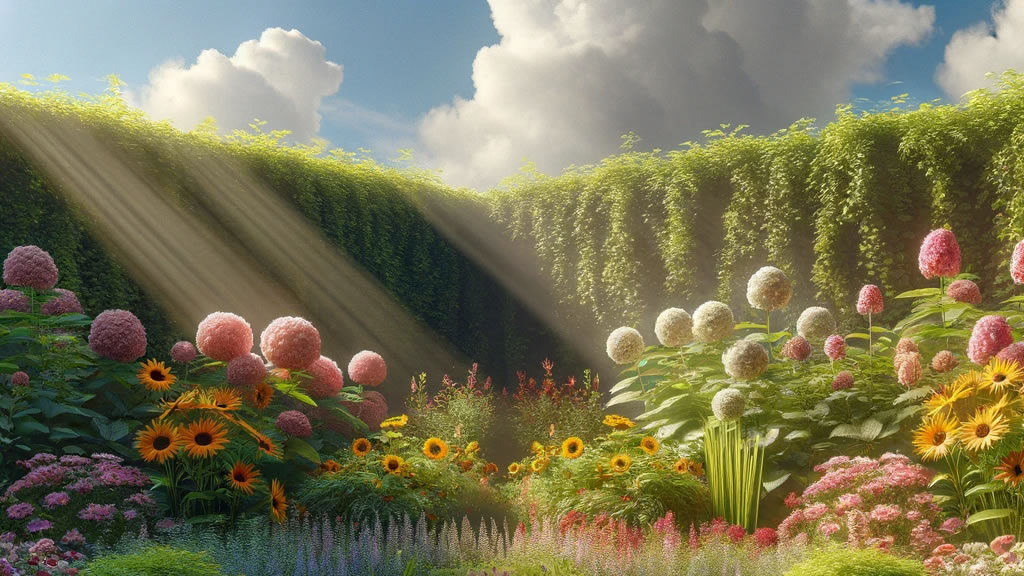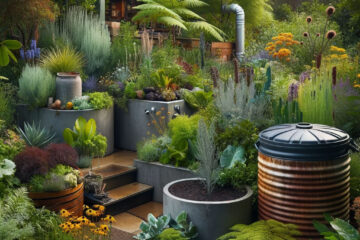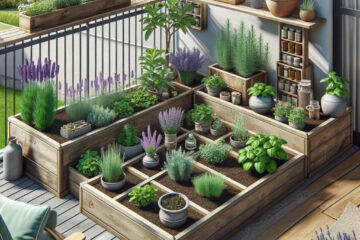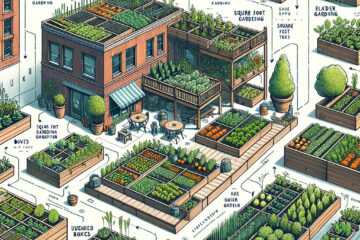Creating a perfect flower bed is a great way to add color and beauty to your garden.
Whether you’re a seasoned gardener or a beginner, designing a flower bed requires careful planning and preparation.
With a little bit of effort and creativity, you can create a stunning flower bed that will be the envy of your neighborhood.
Before you start digging, it’s important to plan out your flower bed. Consider the size and shape of the bed, as well as the types of flowers you want to plant.
Think about the colors and textures you want to incorporate, and make sure to choose plants that will thrive in your climate and soil type.
Once you have a plan in place, it’s time to start preparing the soil and laying out your design.
By taking the time to plan and prepare, you’ll be well on your way to creating a beautiful and thriving Perfect Flower Bed.

Table of Contents
Designing Your Flower Bed
When it comes to designing your flower bed, there are a few key factors to consider that will help you create the perfect look for your landscape.
In this section, we’ll cover some tips for choosing the right location, selecting a color scheme, and incorporating various heights and textures into your design.
Choosing the Right Location
The first step in creating a perfect flower bed is to choose the right location. Consider the amount of sunlight and shade the area receives throughout the day.
Most flowers require at least 6 hours of full sun exposure per day to thrive. If your chosen location is shaded, you’ll need to select plants that are suited to that environment.
Selecting a Color Scheme
Once you’ve chosen the right location for your Perfect Flower Bed, it’s time to start thinking about color schemes.
Consider the colors of your home and surrounding landscape when selecting flowers for your bed.
You can choose a monochromatic color scheme, such as all white or all pink, or you can mix and match different colors for a more vibrant look.
Incorporating Various Heights and Textures
To create a visually interesting Perfect Flower Bed, it’s important to incorporate various heights and textures.
Use plants of different heights to create depth and dimension in your design. You can also mix and match different textures, such as spiky flowers with softer, more rounded flowers.
By considering these factors when designing your Perfect Flower Bed, you can create a beautiful and cohesive look that complements your landscape and adds value to your home.
Preparing the Soil
The success of your flower bed largely depends on the quality of the soil. Preparing the soil beforehand is key to creating a perfect flower bed. Here are some steps to follow when preparing the soil:
Conducting a Soil Test
The first step in preparing the soil is to conduct a soil test. A soil test will help you determine the pH level of your soil and the nutrients it lacks.
You can purchase a soil test kit from your local garden center or have your soil tested by a professional.
Once you have the results, you can adjust the pH level and add the necessary nutrients to your soil.
Amending Soil with Organic Matter
Adding organic matter to your soil is a great way to improve its quality.
Organic matter such as compost, manure, and leaf mold can help improve soil structure, increase water retention, and add nutrients to the soil.
You can mix the organic matter into the soil using a shovel or tiller. Aim to add about 2-3 inches of organic matter to your soil.
Laying the Foundation for Planting
To prepare the soil for planting, you need to create a rich soil bed. Start by removing any weeds, rocks, or debris from the area.
Then, use a garden fork or tiller to loosen the soil to a depth of at least 12 inches. This will help improve soil drainage and aeration.
Once the soil is loosened, add a layer of compost and mix it into the soil. This will help add nutrients to the soil and improve soil structure.
You can also add other organic materials such as peat moss or aged manure to further enrich the soil.
In summary, preparing the soil is an essential step in creating a perfect flower bed.
Conducting a soil test, amending the soil with organic matter, and laying the foundation for planting are key steps to follow.
By following these steps, you can create a rich soil bed that will help your flowers thrive.
Planting and Maintenance
Once you have prepared the soil, it’s time to plant your Perfect Flower Bed. In this section, we will cover selecting plants, planting techniques, and ongoing care and disease prevention.
Selecting Plants for Your Perfect Flower Bed
When selecting plants for your flower bed, consider the amount of sunlight and water the area receives.
Choose plants that are appropriate for the site conditions and your climate. If you are planting annuals, you will need to replant them each year.
Perennials will come back year after year and require less maintenance.
Consider the height and color of the plants you choose. Taller plants should be placed towards the back of the bed, with shorter plants in front.
Use a mix of colors and textures to create interest and variety in your flower bed.
Planting Techniques
When planting your flowers, dig a hole that is slightly larger than the root ball of the plant.
Gently loosen the roots and place the plant in the hole. Fill in around the plant with soil and press down gently. Water the plant thoroughly.
To prevent weeds, apply a layer of mulch around your plants. This will also help to retain moisture in the soil.
Ongoing Care and Disease Prevention
Water your flower bed regularly, especially during dry spells. Be careful not to overwater, as this can lead to root rot and other problems.
Deadhead your plants regularly to encourage new growth and prevent disease.
Inspect your plants regularly for signs of disease or pests. If you notice any problems, take action immediately to prevent the issue from spreading to other plants.
By following these planting and maintenance tips, you can create a beautiful and healthy flower bed that will thrive for years to come.
Enhancing and Protecting Your Perfect Flower Bed
Once you have successfully created your flower bed, it is time to enhance and protect it to ensure its beauty and longevity. Here are some tips to help you do just that:
Using Mulch and Irrigation Systems
Mulch is an excellent way to protect your flower bed from weeds, retain moisture, and regulate soil temperature.
Organic mulch, such as shredded leaves, straw, or bark, is an excellent option as it adds nutrients to the soil as it decomposes.
Spread a layer of mulch around your plants, making sure not to cover the stems or leaves.
In addition to mulch, an irrigation system is a great way to ensure your flower bed receives the proper amount of water.
There are many types of irrigation systems available, such as drip irrigation, soaker hoses, and sprinkler systems. Choose the one that best fits your needs and budget.
Attracting Pollinators and Preventing Weeds
Butterflies and other pollinators are essential for the health and beauty of your flower bed.
Planting flowers that attract them, such as coneflowers, black-eyed susans, and bee balm, will help ensure their presence.
Additionally, installing a butterfly house or feeder can help attract them.
Weeds can be a nuisance and can quickly take over your flower bed.
To prevent them, consider using a landscape fabric or weed barrier underneath your mulch. This will prevent weed seeds from germinating and taking root in the soil.
By following these tips, you can enhance and protect your flower bed, ensuring its beauty and longevity for years to come.
Frequently Asked Questions
What are some creative ideas for designing a Perfect Flower Bed?
When it comes to designing a flower bed, the possibilities are endless. You can create a flower bed in any shape or size you want, and you can use a variety of materials to create borders and paths.
Some creative ideas for designing a flower bed include using rocks, bricks, or wood to create a border, incorporating different textures and colors of plants, and using planters or raised beds to add depth and dimension to your flower bed.
Which plants are best suited for a thriving Perfect Flower Bed?
The best plants for a flower bed depend on a variety of factors, including your climate, soil type, and the amount of sun and shade your flower bed receives.
Some popular plants for flower beds include annuals like petunias, marigolds, and impatiens, as well as perennials like daylilies, hostas, and coneflowers.
It’s important to choose plants that are well-suited to your specific growing conditions to ensure they thrive in your flower bed.
What steps are involved in creating a Perfect Flower Bed from scratch?
Creating a flower bed from scratch involves several steps.
First, you’ll want to choose a location for your flower bed and decide on its size and shape.
Next, you’ll need to prepare the soil by removing any weeds or grass and adding compost or other organic matter to improve the soil’s fertility.
Once the soil is prepared, you can begin planting your flowers, being sure to space them out properly and water them regularly.
How can I effectively create and maintain a border for my flower bed?
Creating and maintaining a border for your flower bed is important for keeping your plants contained and defining the space.
You can use a variety of materials to create a border, including bricks, stones, or wood.
It’s important to choose a material that is well-suited to your climate and will hold up well over time. To maintain your border, be sure to keep it free of weeds and debris and touch it up as needed.
What are the essential tips for beginners starting their first flower bed?
If you’re just starting out with flower gardening, there are a few essential tips to keep in mind.
First, choose plants that are well-suited to your growing conditions and that are easy to care for.
Next, be sure to prepare your soil properly and water your plants regularly. Finally, be patient and don’t be afraid to experiment with different plant combinations and design ideas.
How should I arrange and layer plants for optimal aesthetics and growth in a flower bed?
Arranging and layering plants in your flower bed is important for creating a visually appealing and thriving garden.
As a general rule, taller plants should be placed at the back of the bed, with shorter plants in front.
You can also use a variety of textures and colors to create interest and depth in your flower bed. Be sure to choose plants that have similar growing requirements and that will complement each other well.



